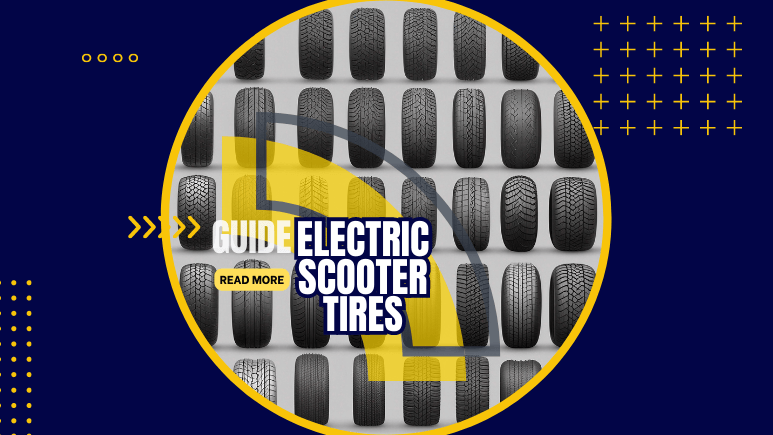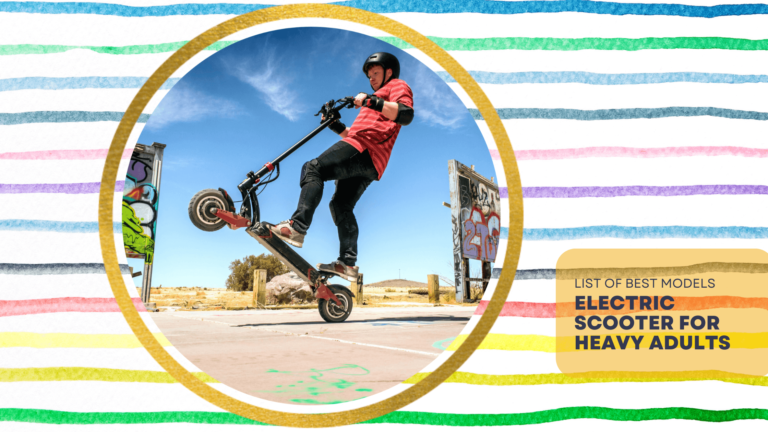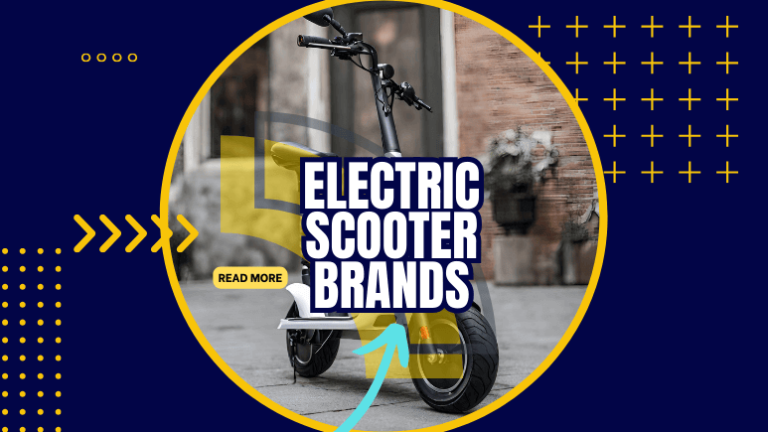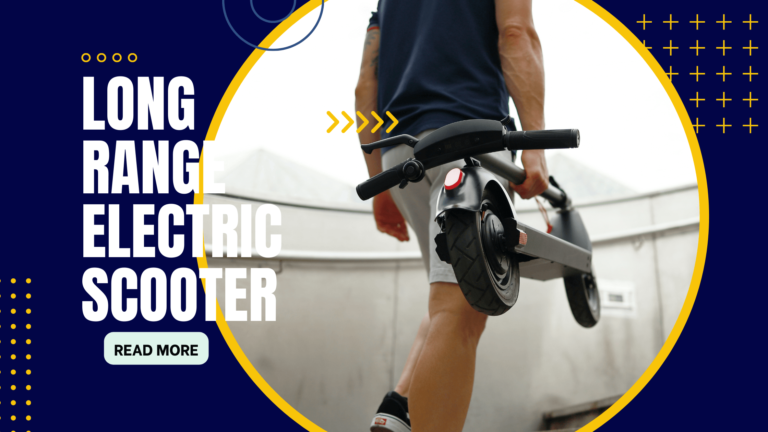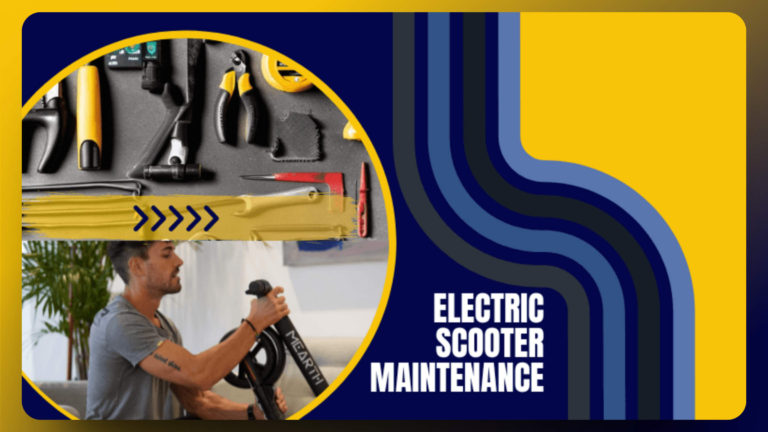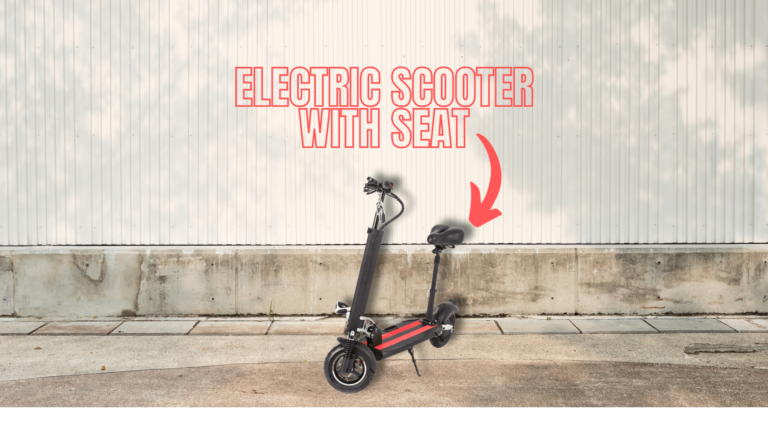One main feature of an electric scooter is what type of tire it comes with. Whether it is for urban commuting or off-road riding, choosing the right tire makes a big difference.
Tires serve as a vital link between your scooter and the ground, playing a crucial role in safety, durability, and ride quality.
In this brief, we delve into the world of electric scooter tires. We will cover different types of tires for all ranges of riders, novice or experienced. This guide will provide you with valuable insights to make an informed decision. Here is what you can expect to learn from below.
What Types of Electric Scooter Tires Are Available?
There are many types of electric scooter tires available in the market.
Each has a unique specification and here we cover them so you can make a sound decision depending on your use case.
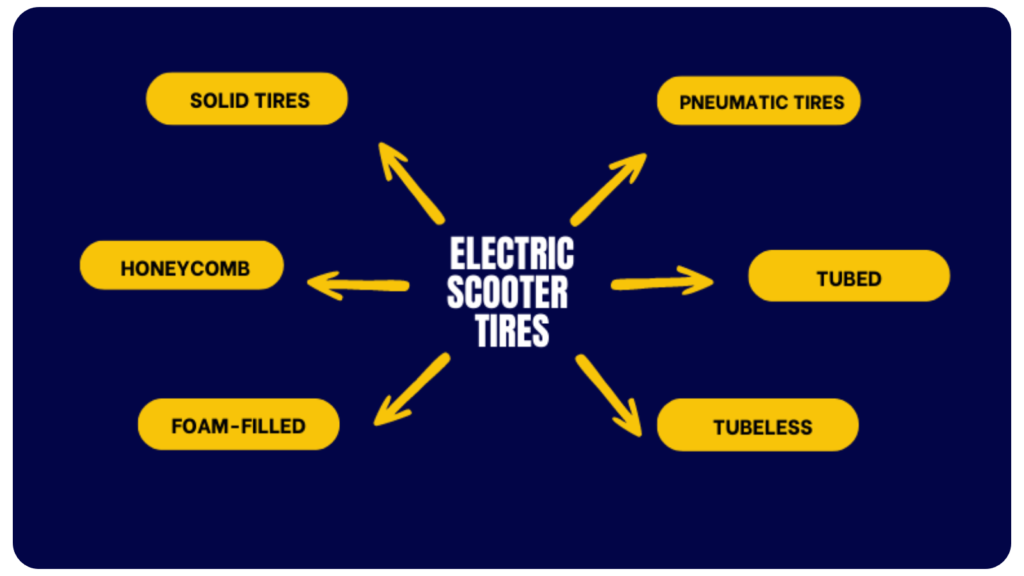
1. Pneumatic Tires (aka Air-Filled)
Pneumatic tires are the most common type of scooter tires that you see in the market.
They are like bicycle tires. It consists of an inner tube that holds the air pressure. Plus, an outer tire that provides traction and protection for the inner tube.
The default option on most electric scooters is Pneumatic tires. They provide cushioning and shock absorption, which can make for a more comfortable ride.
Besides, they provide better performance and handling, particularly on paved surfaces. Yet, somewhat prone to punctures.
There are two main types of pneumatic tires for electric scooters: tubed and tubeless.
Tubed Pneumatic Tires
The Tubed pneumatic tires have an inner tube inside. They offer good shock absorption, a smooth ride, and excellent traction. But, they are more prone to punctures and need regular maintenance.
Some Pros and Cons of Tubed Pneumatic Tires
Here are some Pros of tubeless pneumatic tires:
- Affordability
- Easy to repair
Here are some Cons of tubed pneumatic tires:
- Susceptible to flats
- Tire pressure maintenance
Tubeless Pneumatic Tires
Tubeless tires do not have an inner tube. Instead rely on the tire bead and the rim to seal and preserve the air.
They are filled with high-pressure air and offer strong elasticity and abrasion resistance. Also have excellent adhesion and heat dissipation performance.
Tubeless pneumatic tires provide better stability and less friction at high speeds.
Some Pros and Cons of Tubeless Pneumatic Tires
Here are some Pros of tubeless pneumatic tires:
- Puncture resistance: Tubeless tires are more resistant to punctures. As they do not have an inner tube.
- Self-sealing: Self-sealing property is when they can seal small punctures on their own. This reduces the risk of flats.
- Lower rolling resistance: This means less force to move so better acceleration, and braking.
- Better ride quality
- Adjustable air pressure
Here are some Cons of tubeless pneumatic tires:
- Higher cost: generally more expensive than tubed tires, both for initial purchase and maintenance.
- Complex installation and repair
- Heavier
2. Solid Tires
Solid tires are exactly what they imply – they have a solid construction with no inner tube. Ideal for anyone who wants to avoid the hassle of dealing with tire punctures and replacing inner tubes.
Solid tires are rigid and do not need inflation. They are puncture-resistant and can handle tougher terrain.
But, they tend to provide a rougher ride and are not as shock-absorbing as pneumatic tires.
Solid tires’ main use is on city streets and paved surfaces.
There are three types of solid tires: fully-solid tires, honeycomb, and foam-filled tires.
Fully-Solid Tires
These are the most common solid tire type for electric scooters.
The material of these tires is natural/synthetic rubber or silicone. So it makes them the heaviest option and adds a lot of weight to the scooter.
Fully-solid tires are an affordable option but offer the worst ride quality. They tend to wear out fast due to the lack of deep treads.
Honeycomb Solid Tires
Honeycomb tires have a honeycomb structure and holes to enhance ride quality.
They have solid materials like silicone and rubber.
Shock absorption is better in these tires than in fully-solid tires. But have less traction and a bumpier ride compared to pneumatic tires.
Foam-Filled Tires
Foam-filled tires are filled with foam instead of air. This provides more cushioning and shock absorption than other solid tire types.
They offer better ride quality than fully solid and honeycomb tires. Yet, still have less traction and shock absorption compared to pneumatic tires.
Factors to Consider When Selecting Electric Scooter Tires
When you choose an electric scooter, you must look at what to consider: your personal preferences, riding style, and terrain.
Here are some factors to consider:
- Tire Types: Choosing between pneumatic and solid tires.
- Tread pattern: The tire’s tread pattern affects its performance on different terrains. For smooth pavement, a less aggressive tread pattern is suitable. While off-road riding requires a more aggressive tread pattern for better grip and stability.
- Tire Size: The size of the tire affects the handling, stability, and ride quality. Larger tires generally provide better handling and stability. While smaller tires are lighter and more manoeuvrable.
- Ride Quality: Consider the ride quality you desire. Pneumatic tires offer better shock absorption and a smoother ride compared to solid tires. If ride quality is a priority, opt for pneumatic tires.
- Maintenance requirements: Pneumatic tires need more maintenance, such as regular tire pressure checks and potential puncture repairs. But, solid tires are low maintenance. If you prefer less maintenance, solid tires may be a better choice.
- Terrain adaptability: Pneumatic tires are generally more adaptable to various terrains.
- Budget: Tubed pneumatic tires are generally more affordable than tubeless pneumatic tires. Also, solid tires are the most affordable option but offer lower ride quality.
Electric Scooter Tire Tread Options
There are various tire tread options for electric scooters. It depends on the type of terrain and riding style.
Here we are covering some common tread options:
Off-Road Treads/Tires
Off-road treads are for rough terrain, such as dirt, gravel, or grass.
These treads have deep, aggressive patterns that provide better grip and traction on uneven surfaces. These tires are suitable for those who ride on rough terrain or in areas with a high risk of punctures.
Here are some benefits of off-road tires in rough terrain:
- Better grip and stability
- Improved shock absorption
- Durability
- Versatility
- Better manoeuvrability
Off-road tires can have an impact on the speed and range of electric scooters.
This is because the tread pattern is much deeper and wider on these tires. This increases the rolling resistance and reduces the speed and range of the scooter. Plus, reduces the battery energy required to move the tire.
Another reason is the tire size which is generally larger and wider. Larger tires can provide better traction and allow for higher speed. But they are heavier and reduce the range of the scooter.
Air pressure of the off-road tires can also have an impact. As you know lower tire pressure provides better traction but reduces the speed and range.
If we are comparing the road tires with off road tires then road tires are preferred over off-road tires. In most of the conditions they perform well except maybe for muddy or wet terrains.
Road tires usually last longer with font tire lasting somewhat around 1,500 to 2,000 miles and the rear tire lasting shorter due to more spinning.
Note that off-road tires create more noise at high-speed compared to road tires.
You might be interested to read about these briefs as well on off-road electric scooters and budget-friendly off-road electric scooters.
Smooth Pavement Treads
Smooth pavement treads are for smooth paved surfaces. These treads have a less aggressive pattern, providing a smoother ride.
Good for daily commuting or casual rides on well-maintained roads and sidewalks.
All-Terrain Treads
All-terrain tires have become the go-to choice for many riders. Because of optimal performance and versatility on a wide range of surfaces.
These tires are made to handle both on-road and off-road conditions.
They have a more aggressive tread pattern than standard street tires.
All-terrain tires handle different terrains without compromising too much on-road performance.
The construction of all-terrain tires involves several key components. With a strong bead, tougher plies, and a thicker rubber tread, these tires are designed to withstand the cutting, tearing, and deformation caused by off-road surfaces.
Understanding Tire Size and Shape
Electric scooter tires come in various sizes, ranging from 6 to 16 inches in diameter.
The size of the tire can impact the scooter’s handling, comfort, and safety.
Larger tires often have better shock absorption, improved traction, and a smoother ride. Plus, capable of handling rough terrain and rolling over obstacles. Some key benefits are:
- Stability
- Handling
- Safety
- Terrain adaptability
Smaller tires are easier to manoeuvre and more suitable for beginners.
- Manoeuvrability
- Weight
The most common tire sizes for electric scooters vary depending on the type of scooter. For commuter users, the typical tire size is 8 inches. While off-road electric scooters usually have 10-inch tires.
The tire shape is another feature that can affect the speed and handling of electric scooters. The tire shape is also known as the tire profile. Some key impacts of the type of tire profile are:
- Cornering speed: round tires have better corner speed than square tires
- Grip and traction: square tires provide better traction and grip in general
- Terrain adaptability: larger tire diameters give a better, smoother, and safer ride. Easier to roll over roadblocks.
- For higher speed: round tire profile generally performs better at higher speed because of lesser contact points with the ground.
The correlation between tire size and motor power is that as tire size increases, so does motor power. The size of the tire somewhat reflects the size of the motor as motors mount within the scooter’s wheel hubs.
A budget scooter with a small motor may only have tires that measure 8.5 inches in diameter. While a more powerful scooter ( high-performance) often has larger tires i.e. 10-11 inches in diameter.
The tire size and motor power have a crucial relationship that impacts the scooter’s performance. Larger tires are for powerful motors, enabling higher speeds and better handling on rough terrains. Smaller tires with lower motor power are ideal for urban commuting and lighter usage.
Tire Materials Used in Electric Scooters
The material of electric scooter tires varies depending on the use case, model and brand of scooter.
Some of the best materials used in tires for high-speed electric scooters are those that have good grip, durability, and stability.
Let’s start with Silicon. It is a popular material and is often used in solid tires. Another good material is rubber which is common in electric scooter tires.
Polyurethane is a synthetic material which is yet common in solid tires. Also, can withstand high speed and heavy use.
Nylon is also very often used in pneumatic tires. It is strong and durable in general.
Tire Maintenance Tips For Electric Scooters

Are you tired of having to replace your electric scooter tires sooner than their due date?
If that’s the case, we are going to give some tire maintenance tips. Keep reading to learn more!
Tip 1: Tire Pressure (Avoid Over/Under Inflation)
The recommended tire pressure for most electric scooters is between 40 and 50 PSI.
But, the ultimate tire pressure number can vary depending on the:
- Rider weight
- Scooter model
- Weather conditions
For accurate tire pressure check your scooter’s user manual or the side of the tire for correct pressure.
If you keep the proper tire pressure, it gives you:
- Smoother riding experience
- Better control
- longer tire life
Tip 2: Checking And Adjusting Tire Pressure
Make sure to check and adjust your tire pressure using the tire gauge and source of air.
Unscrew the valve stem cap, check the pressure with the gauge, and fill the tire to the correct PSI. As indicated in your scooter’s user manual.
Regular check on your tire pressure helps prolong the life of your tires and ensures a safer riding experience.
Tip 3: Regular Check For Wear And Tear
Do you have a scooter that has pneumatic or solid tires? It’s crucial to have a regular inspection on them for wear and tear.
Look for signs of damage, such as cuts, punctures, or worn treads.
Replace tires when the treads get too low or if you notice any other issues that could compromise their performance.
Tip 4: Tire Rotation For Even Wear
Unlike in cars. Tire rotation is not common for electric scooters due to different tire sizes.
Some scooter owners rotate their tires every couple of thousand miles to promote even wear.
If the scooter has identical front and rear tires, you can rotate the tires to extend the tire lifespan. Keep in mind that this process may be time-consuming and may not give a significant benefit.
Tip 5: Timely Tire Replacement
When your electric scooter tire becomes worn or damaged it is crucial to replace the tires to maintain performance and safety.
Tires usually need replacement every few thousand miles based on usage.
Signs To Replace Electric Scooter Tires
When you find yourself staring at the wear and tear on your scooter tires, you might be wondering if you need to change them immediately.
To maintain optimal performance and safety you need to change the tires when they get damaged.
Here are some signs that show it’s time to replace your electric scooter tires:
- Tread Depth: tread depth is the distance between the top of the tire and the bottom of its grooves. Usually, when the tread depth gets to 1mm or less, you should consider replacing the tire. You can use the tire wear indicator which are small bumps in the grooves to determine when the tread is in legal limit.
- Uneven Tread Wear: uneven tread wear can be due to improper tire pressure, misaligned wheels, or other issues. This also requires the replacement of the tire.
- External And Internal Damages: inspect your tire for any visible damages such as cuts, punctures, cracks, or bulges.
- Tire Aging: the lifespan of the electric scooter tire can get affected by many factors. Such as riding style, tire pressure, weather conditions and road conditions. As a precaution, it makes sense to change the electric scooter tires every 2-3 years, even regardless of mileage.
- Mileage: the average electric scooter tires need to change every 2,000-3,000 miles. But, this can vary depending on usage frequency, riding condition, scooter weight, etc.
Benefits Of Maintaining Proper Tire Pressure
A scooter, much like a bike, relies on proper tire pressure to provide an optimal and efficient way of transportation.
Maintaining proper tire pressure is essential for many reasons. Here are some benefits:
- Smoother riding experience: when tire pressure is optimal it makes the ride smoother. Gives better shock absorption and reduces vibration on uneven surfaces.
- Improved control: proper tire pressure makes the handling and manoeuvrability precise.
- Higher Speeds: correct tire pressure reduces rolling resistance. This makes your scooter travel at high speed with less effort from the motor and battery.
- Safety: optimal tire pressure makes sure the optimal grip and reduces the risk of an accident.
- Cost efficiency: good tire pressure makes the tire life longer.
Prevent Flats On An Electric Scooter Tires
Preventing flats on your electric scooter is important for a hassle-free riding experience. You may follow these methods to help you avoid flat tires:
- Maintain Proper Tire Pressure: Keeping the correct tire pressure is essential to prevent punctures. Under-inflated tires are more vulnerable to damage. While over-inflated ones can lead to blowouts. Check the tire pressure and adjust it according to the manufacturer’s recommendations.
- Use Tire Sealant (Tire Slime): Tire sealant, also known as tire slime, is a liquid injected into the tire to prevent flats and seal punctures. It creates a protective barrier inside the tire, guarding against sharp objects and reducing the risk of flats.
- Consider Tire Liners: Install flexible, heavy plastic, or rubber tire liners between the inner tube and tire for added protection against punctures. This is especially beneficial for electric scooters with inner tube tires.
- Explore Airless (Solid) Tires: If you want to avoid flat tires altogether, consider using airless or solid tires. These tires are made of solid rubber, eliminating the need for air pressure and making them puncture-resistant. Keep in mind that they may provide a less comfortable ride compared to pneumatic tires due to reduced shock absorption.
Bent-Valve Electric Scooter Tubes
Bent-valve electric scooter tubes are inner tubes designed for electric scooters with a bent valve stem.
The advantage of a bent valve is making the inflating easier and provides better clearance when the wheel is turning.
These tubes are made of high-quality materials, such as butyl rubber, which offer good puncture and tear resistance.
Some of the main features of Bent-valve electric scooter tubes are:
- Thicker material
- Compatibility
- Easy installation
- High-quality valves
- Puncture and wear resistance
Differences Between the Bent Valve and Straight Valve Tubes
The main difference between bent valve tubes and straight valve tubes for electric scooters is the shape of the valve stem.
Bent valve tubes have this cool angled valve stem, usually at 45 or 90 degrees. This makes it super easy to inflate and gives enough clearance when your wheel is turning. No more worries about the valve hitting the scooter fork!
These bent valve tubes are like the go-to choice for electric scooters with smaller wheels. The angle of the valve stem makes inflation a breeze!
But, you got the straight valve tubes, with their valve stem going perpendicular to the tube.
They’re common and used in all sorts of applications, including electric scooters. But, gotta admit, they might offer a different clearance and ease of inflation than the bent ones, especially with smaller wheels.
Also you may be interested in these briefs:

